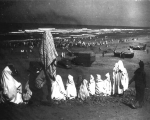
There are three main dialects in Morocco: "Trifit " is spreading over the north , " Tachalhit" over the middle and the western south , "Tamazight" over the Eastern side , but quite different that, the ones who speak them, can understand each other. Each of these groups has several common words and glossaries as well as we find a lot of Berber words introduced in the Arabic dialect called "Darija". The Baamranis language isn't homogeneous that means mix between "Tachalhit" which dominates almost of Ait Baâmran clans area except the south where we find the Sahara arabic dialect seems like "Hassania'' dialect extended along South Morocco. The citizens of Ifni, descendant of old Berbers, coexist with Arabs; quite pure, and some Jews. Therefore, the Berber Baamrani, the Arabic and some African dialects, are spoken in Ifni. The language of Ifni is the Berber Susi, known as “Tachelhit”.
According to the “Spanish-Baamrani Dictionary” by P. Esteban Ibañez, the dialect Susi is spoken by the natives in Anti Atlas, Gran Atlas and regions of Sus and Dra. It is the purest and less influenced by other languages, especially the Arabic.
Ifni, or the territory of Ait Ba Aamrán, belongs to the linguistic sphere of Susi dialect. The natives of this region speak the language of Berber Susi. Therefore, Baamranis’ language has many similarities to other brother groups. A Baamrani, that leaves his territory, understands easily the language of the natives in the region of the Berbers. The same happens in the Rif, to a native of Beni Urriaguel who goes to Ghehia.
There are three main dialects in Morocco: “Rifeño”, Berber and Susi, but so different that, the ones who speak them, do not understand each other. Each of these groups has several dialects, with different grammar and vocabulary. The Baamranis of Ifni belong to the group of sub dialect Susi, keeping their own characteristics in spite of the close relationship the have with their neighbors.
In Sidi Ifni you can also find all the regional dialects of Spain together with the already mentioned. The contrast is obvious, in a country where races, languages and dialects are completely different, though they all understand Spanish.
The Arabs born in the plains and cities have lost the pureness of the language and they express themselves in vulgar MOROCCAN ARABIAN. The nomads of the desert, in Sidi Ifni, keep their Arabic “hasania”, mixed up with the Berber “aser”, or Sudanese with the Arabic.
The Berber Baamrani is mainly used as a family language, as most of them, at least the men, speak it, but very few of them can write it. The tribe where Arabic is mostly spoken is in Isbuia, in touch with Presaharian tribes who speak the Arabic “hasania”.
The Negroes and “Negruidas”, who came in many occasions from Morocco and Sudan, speak the language depending on the place they come from, either Arabic or Berber. But all this mixture of races and languages, coexist under the shelter of Spain, which makes no differences of race or color.
In the linguistic map of Ifni, we can clearly see the Berber, Arabic and bilingual areas. The territories where the “Baamrani” (Berber-susi) is spoken are the following: Ait en Nus, Ait Jassa, Ait Ijelf,Ait Aabel-la, Imstiten, Ait el Joms and Asnaga. The “hasania” is spoken in Ait Iusin, Id Iago, both in Isbuia. Aabel-la u Brahim, also in Isbuia, is bilingual.